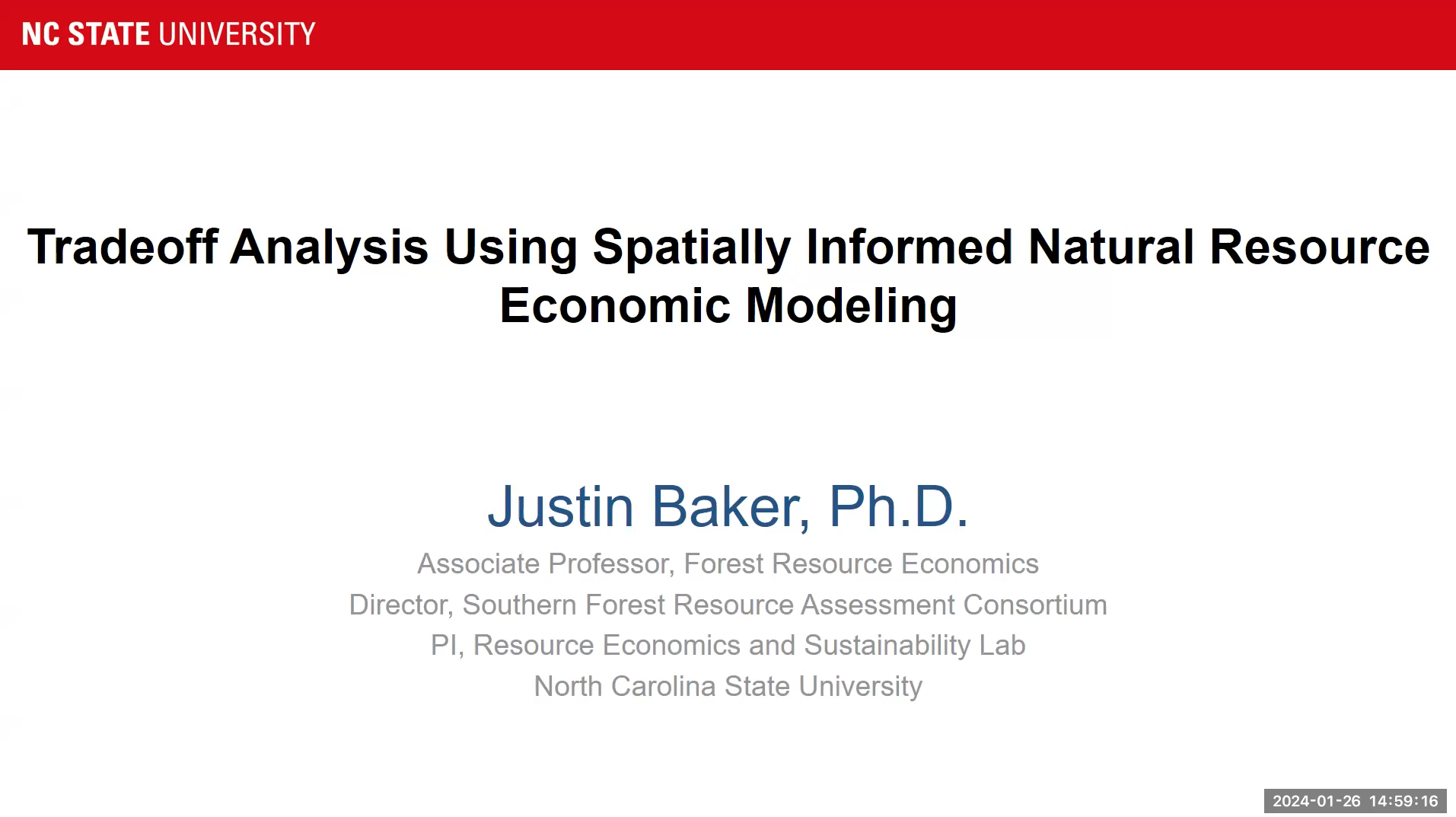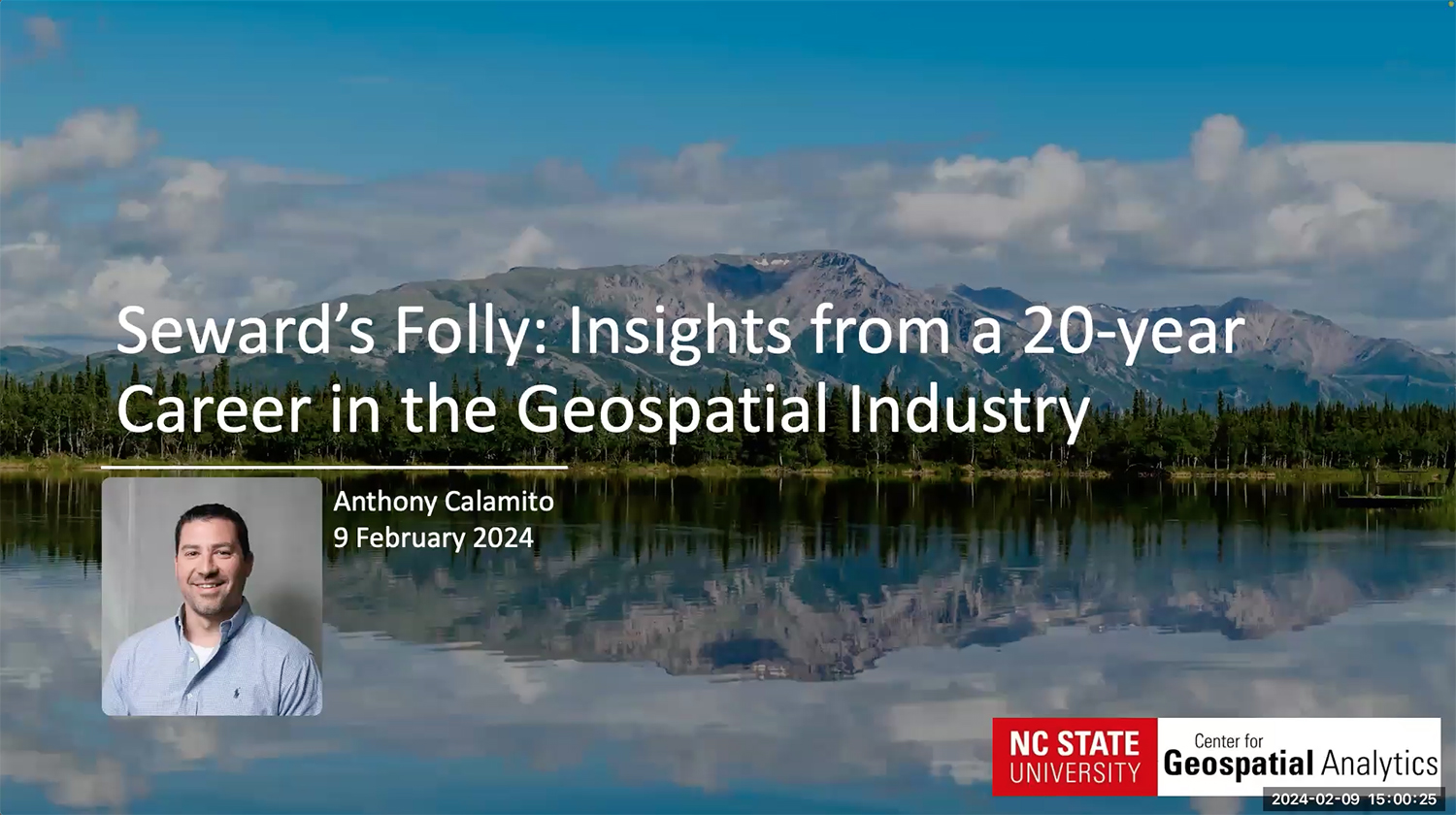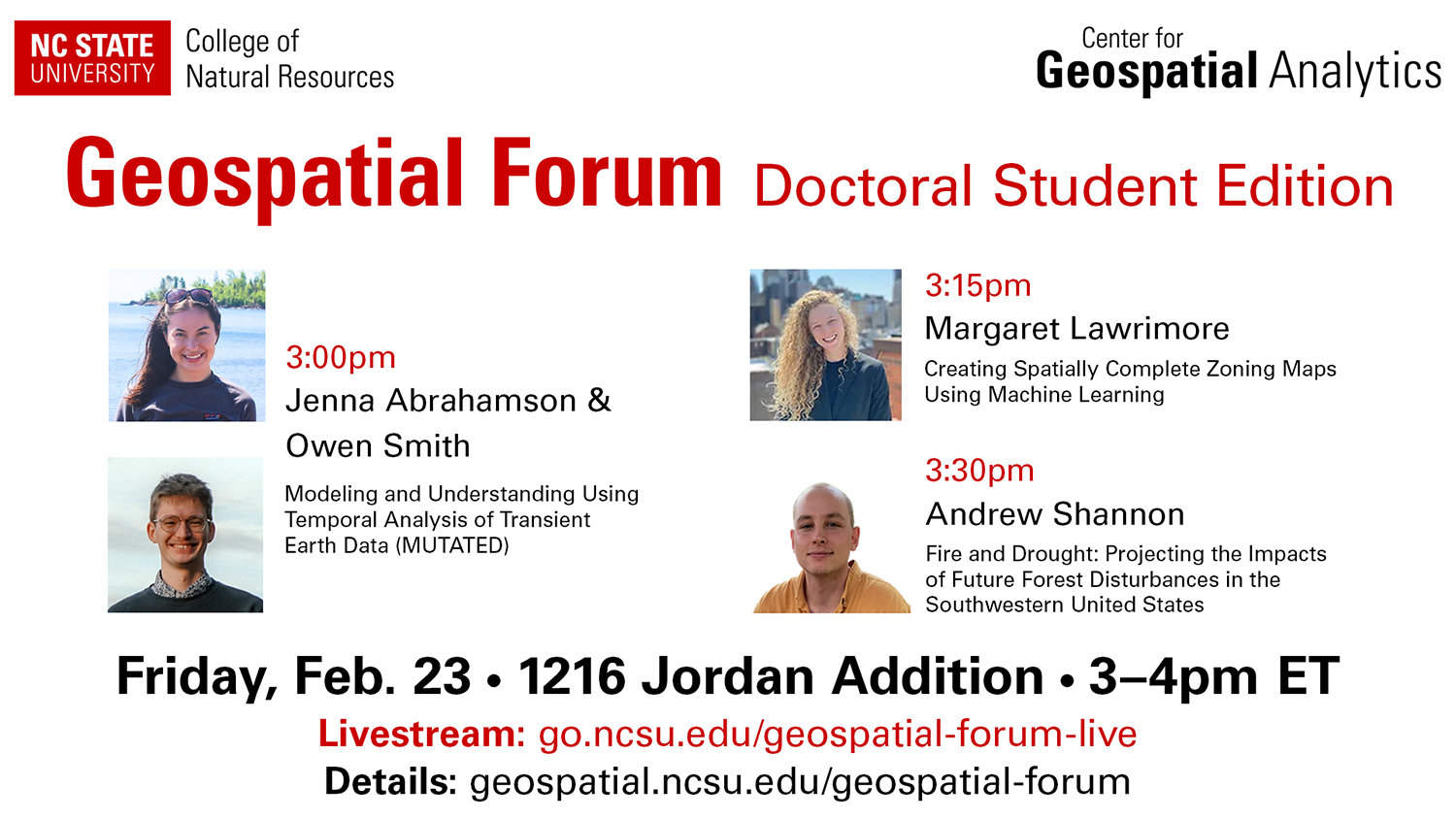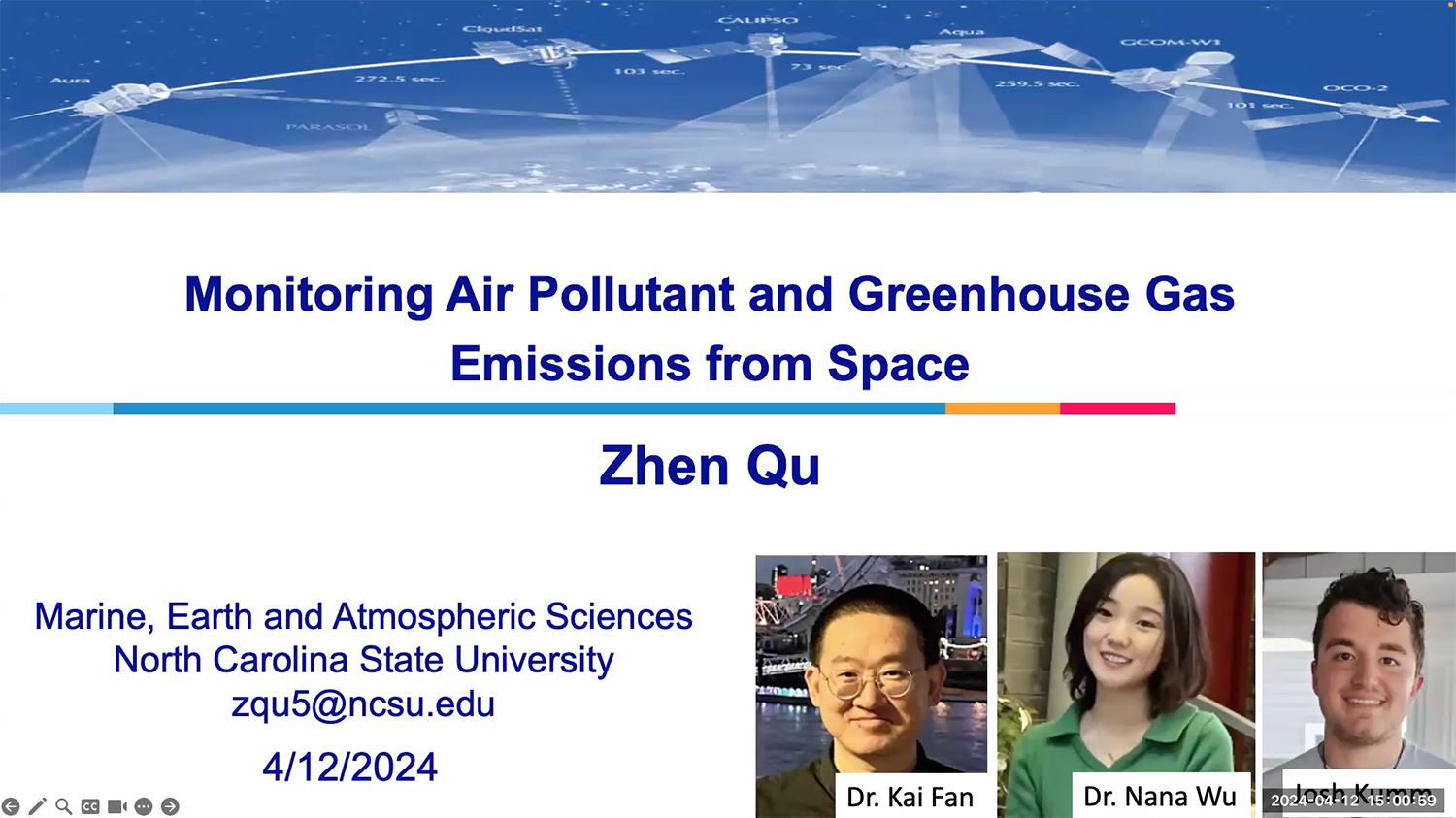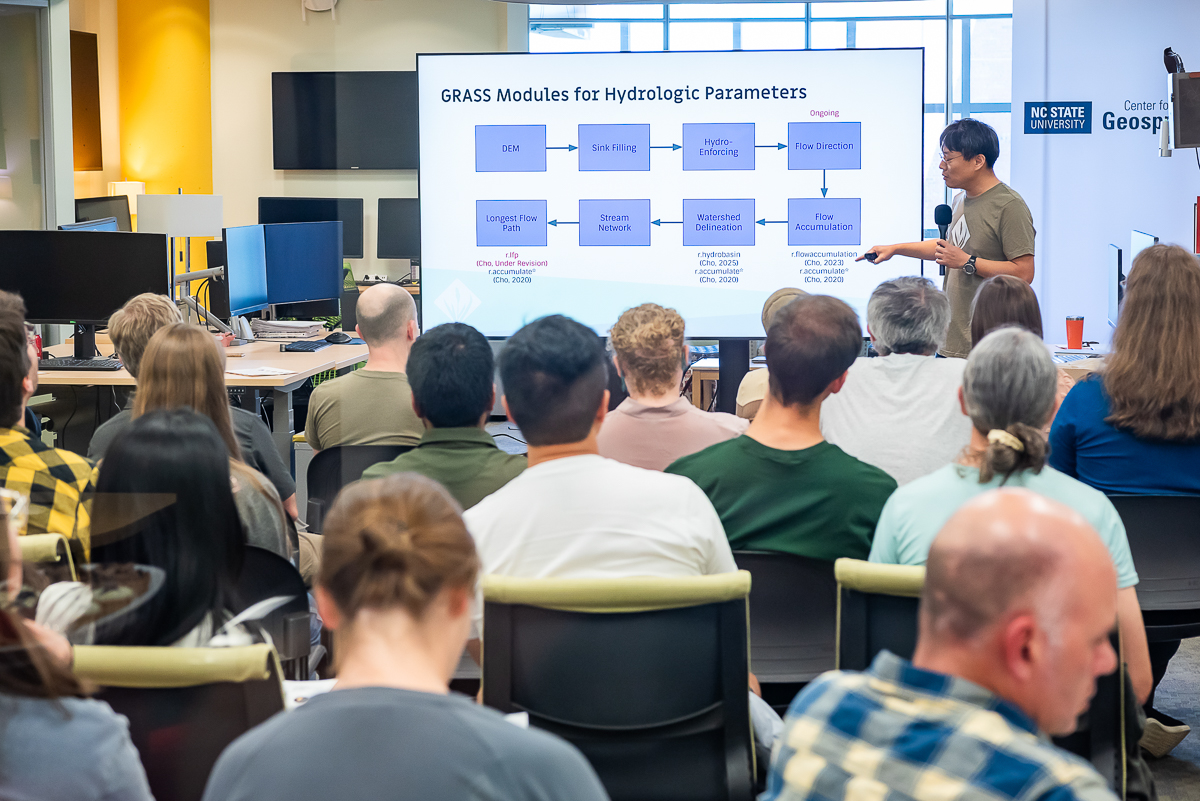Spring 2024 Geospatial Forum Rewind
Revisit the Center for Geospatial Analytics' Spring 2024 Geospatial Forum series.
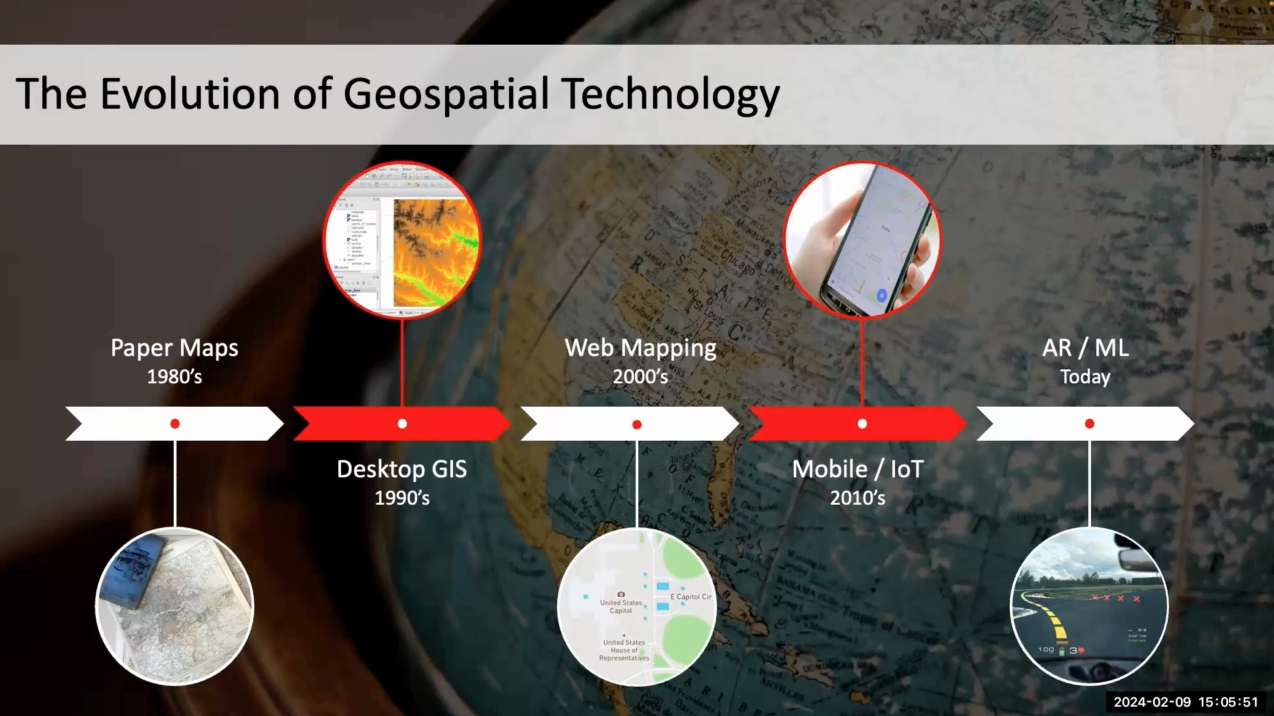
Each semester, our Geospatial Forum event series brings together researchers, educators, practitioners and students in the geospatial data sciences for lectures, interactive studios and panel discussions focused on important topics and cutting-edge techniques.
This spring, Geospatial Analytics Ph.D. students presented their doctoral research, an alumni panel discussed geospatial careers and guest speakers presented topics ranging from natural resource economics to air pollution and lessons from twenty years in the geospatial industry.
Expand each title below to learn more and click the play button to revisit each recorded discussion.
Remember you can watch the recordings from past semesters anytime on our YouTube channel.
JAN 26 – Tradeoff Analyses Using Spatially Informed Natural Resource Economic Modeling | Lecture
Lecture
Speaker: Dr. Justin Baker (NC State)
About the speaker: Dr. Justin Baker is an associate professor in NC State’s Department of Forestry and Environmental Resources. Justin uses geospatial analytics and structural economic models to capture spatial and temporal dependencies between markets, natural resource systems, infrastructure and policy constraints. He develops research questions covering a wide range of modeling topics, including forestry and agricultural sector projections, food-energy-water nexus sustainability, climate change mitigation and adaptation policy, interactions between trade policy and the environment, and energy policy. He also is the Director of the Southern Forest Resource Assessment Consortium (SOFAC), directs the Resource Economics and Sustainability Lab, is a faculty affiliate with the Center for Environmental and Resource Economic Policy (CEnREP), a research theme lead for the NSF STC Science and Technologies for Phosphorus Sustainability (STEPS) Center, and holds a guest researcher affiliation with the International Institute for Applied Systems Analysis (IIASA).
FEB 9 – Seward’s Folly: Insights from a 20-Year Career in the Geospatial Industry | Lecture
Lecture
Speaker: Anthony Calamito (GEO261 & Center for Geospatial Analytics Advisory Board)
Summary: Are you considering a career in geospatial? Perhaps you’re a few semesters in wondering what types of jobs are available after you graduate. The geospatial landscape has changed greatly over the last 20 years, from a niche industry that few knew about, to technology that is found on every cell phone in the world. In this forum, Anthony Calamito will share his insights and lessons-learned from a 20+ year career in the geospatial industry (the good, the bad, and the ugly), then provide his thoughts on where things are going in the future.
About the speaker: Mr. Calamito is Vice President and Co-Founder of GEO261, helping organizations perform product-market-fit analysis and construct go-to-market strategies optimized for growth. He began his career as a GIS Analyst, subsequently filling roles as Chief Geospatial Officer, VP of Product, and Chief Evangelist for several large geospatial software companies. Anthony maintains ties to the academic community having been an adjunct instructor for George Mason University, and a current Fellow of the American Geographical Society. Anthony earned his BS in Geography from Penn State University.
FEB 23 – 4th Doctoral Student Forum | Lecture
Lecture
Speakers and abstracts:
> Jenna Abrahamson & Owen Smith: Modeling and Understanding using Temporal Analysis of Transient Earth Data (MUTATED) (advised by Josh Gray)
Abstract: Monitoring land cover change is crucial for timely detection of deforestation and other anthropogenic activities relevant to climate change and intelligence. Bayesian statistical methods are powerful for change detection because they can detect change without relying on long, stable periods of data to train on. However, applying such algorithms in near-real time across the globe while maintaining high levels of accuracy and computational efficiency is challenging. Our work highlights the application of roboBayes, a novel change detection algorithm that enables the broad-area search of multi-source satellite imagery to detect, monitor, and characterize the progression of heavy construction events across Earth.
> Margaret Lawrimore: Creating Spatially Complete Zoning Maps Using Machine Learning (co-advised by Georgina Sanchez and Ross Meentemeyer)
Abstract: Zoning regulates land use and intensity of urban development at the county and municipal level in the United States, promoting economic growth, community health, and environmental preservation. However, the limited availability of zoning data at scale hinders regional assessments of regulations and coordinated resilience planning efforts. Therefore, we developed an open-source, replicable, and transferable framework to predict spatially complete zoning. We applied the Random Forest algorithm statewide in North Carolina, USA. We found ~98% accuracy filling gaps within county zoning, but representative training data is required.
> Andrew Shannon: Fire & Drought: Projecting the Impacts of Future Forest Disturbances in the Southwestern United States (advised by Robert Scheller)
Abstract: Dry forests in the southwestern United States have experienced increasing disturbances from wildlfire and drought in recent decades, and it is uncertain how these disturbances will impact forest regeneration and mortality patterns under hotter and potentially drier climate futures. In this research, we examine the interactions between drought-driven and wildfire-driven tree mortality across public lands in Northern Arizona using a dynamic, spatially explicit simulation of forest succession and disturbance. This work highlights the role of future climate and vegetation structure in altering the disturbance regimes of these forests in the absence of changes to present day management patterns.
Hosted by: Rachel Kasten, CGA’s University Program Specialist.
MAR 22 – Where Are They Now? A Panel Discussion with Center Alumni | Panel
Panel
A panel discussion with Center alumni about their career trajectories and the role geospatial analytics has played in their professional lives since graduation.
Panelists:
> El Cardenal (GISCert 2020; MS MEAS 2020): Geoscientist @ AECOM
> Brett Cox (GISCert 2017; MGIST 2020): Research Manager @ JLL Carolinas
> Peter Erlenbach (MGIST 2021): Solution Engineer @ Esri
> Kellyn Montgomery (PhD 2021): Geospatial Modeler @ USDA
> Vini Perin (PhD 2022): Geospatial Software Engineer @ Planet
Moderated by: Dr. Eric Money, Associate Director of Educational Innovation at the Center for Geospatial Analytics
More about the panelists:
El Cardenal is a Geoscientist with AECOM working on mid- to large-scale federal projects for 4 years focusing primarily on stormwater, groundwater and drinking water. El uses database management, spatial analysis, field investigations, mapping, research, permitting and reporting to better understand water infrastructure condition, capacity and function. These actions are sometimes driven by EPA laws and regulations such as The Clean Water Act and more presently, the Lead and Copper Rule Revision. El serves as a technical lead on GIS deliverables, leads a quarterly GIS seminar in the AECOM Raleigh office, and has presented case studies at multiple regional conferences. Outside of work, El has two rescue dogs and reads as many books as they can get their hands on.
Brett Cox is a Research Manager at JLL Carolinas where he is responsible for research operations in the Carolinas, including data management and analysis, market reporting, and thought leadership. Brett’s team covers Charlotte, Raleigh-Durham, Charleston, and the rest of the Carolinas and their office, industrial, multi-housing, and life sciences markets. He specializes in implementing geospatial tools and JLL’s proprietary Blackbird visualizations to help decision- makers access and understand the latest and most relevant data. Before joining JLL, Brett performed the roles of Consultant, Senior Data Analyst, and Customer Success Manager at geospatial consultation and SaaS companies. Before that, he was an educator in the public school system.
Peter Erlenbach is a Solution Engineer at Esri within the State and Local Government Global Business Development division. Peter holds a Master’s in Geographic Information Science from North Carolina State University. Prior to his graduate career, Peter graduated from Virginia Tech with a focus in Geography and dual minors in GIS and Geology. Peter has roughly a decade of professional experience where he primarily focuses on helping State and Local Governments address key business challenges with GIS software. Within the realm of GIS, Peter enjoys python scripting, web & mobile GIS, and field mobility workflows. When he is away from his desk, you can find Peter jogging, hiking, and enjoying the outdoors.
Kellyn Montgomery is a Geospatial Modeler on the Phytosanitary Advanced Analytics Team at USDA APHIS PPQ based out of Roanoke, VA. She was a member of the first cohort of the CGA’s Geospatial Analytics PhD program at NC State, graduating in 2021. Her dissertation focused on developing geospatial tools for pest management and biosecurity. Previously, she was a program manager for agriculture nonprofits and NC Cooperative Extension and did freelance GIS work for vineyard management. She enjoys hiking, camping, biking, music, and pickleball.
Vini Perin is a Geospatial Software Engineer with a background in agriculture, hydrology, remote sensing and GIS. Vini currently works with the Planet Labs’ Planet Basemaps team.
APR 12 – Monitoring Air Pollutants and Greenhouse Gases from Space | Lecture
Lecture
Speaker: Dr. Zhen Qu (NC State)
Introduction by: Dr. Sandra Yuter, Distinguished Professor at NC State
Summary: Robust predictions of air pollution and climate forcing require better representations of air pollutant and greenhouse gas emissions than we have at present. In this forum presentation, Dr. Zhen will show how satellite observations, an atmospheric chemical transport model, and statistical methods are applied to estimate the sources of major air pollutants and a greenhouse gas. She will discuss how her team improves the spatial distribution, trend, and sectoral contribution of the emissions of nitrogen oxides (NOx), sulfur dioxide (SO2), and carbon monoxide (CO). Next, she will demonstrate how source attribution is applied to identify the most effective ways to achieve healthy air quality levels. Finally, Dr. Zhen will use satellite observations to explain the trend and recent surge of global methane (CH4) concentration in 2020 and 2021. Understanding the sources and evolution of these gases is essential for developing effective air quality and climate change regulations.
About the speaker: Dr. Zhen Qu is an assistant professor in NC State’s Department of Marine, Earth and Atmospheric Sciences. Zhen is an atmospheric chemist and uses geospatial analytics to investigate how human activities are altering atmospheric composition and chemistry, and how these changes interact with climate change. She utilizes statistics, high-performance computing and satellite observations to investigate the sources, chemical formation, spatial distributions and trends of air pollutants and greenhouse gases. She develops algorithms and modeling approaches to expand our process-level understanding of man-made and natural emissions. She also applies atmospheric chemistry models to understand the sensitivity of air pollution and its exposure to the emissions of precursor gases. Zhen leads the Qu Group at NC State, a group of post-docs and students that apply data driven methods to understand air pollutants, greenhouse gases, and their interactions with climate and society.
- Categories:
